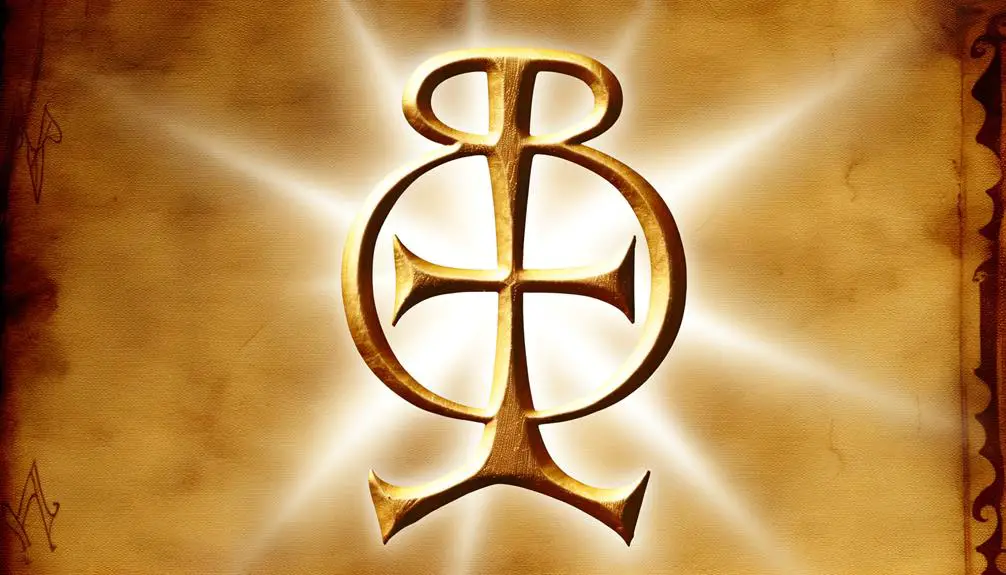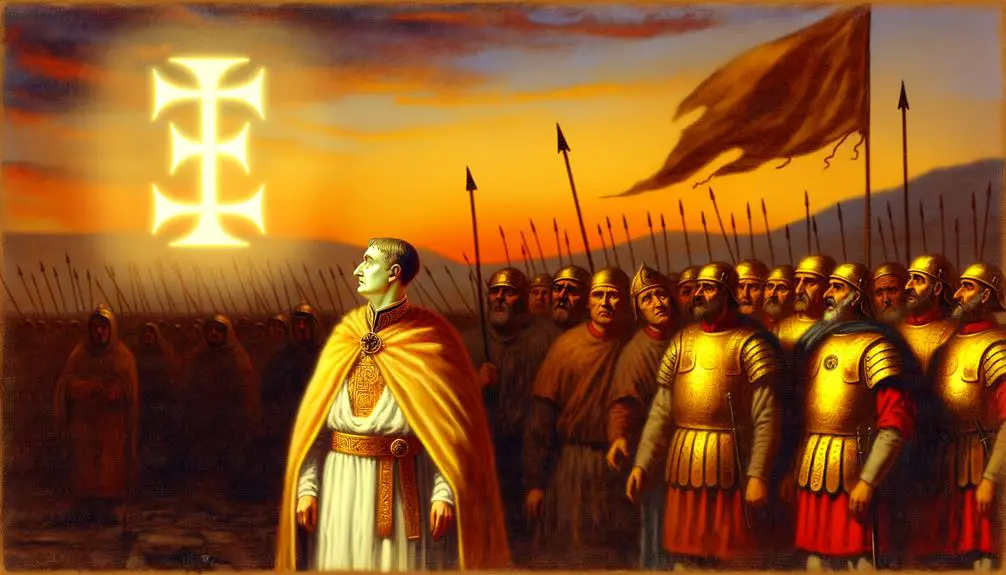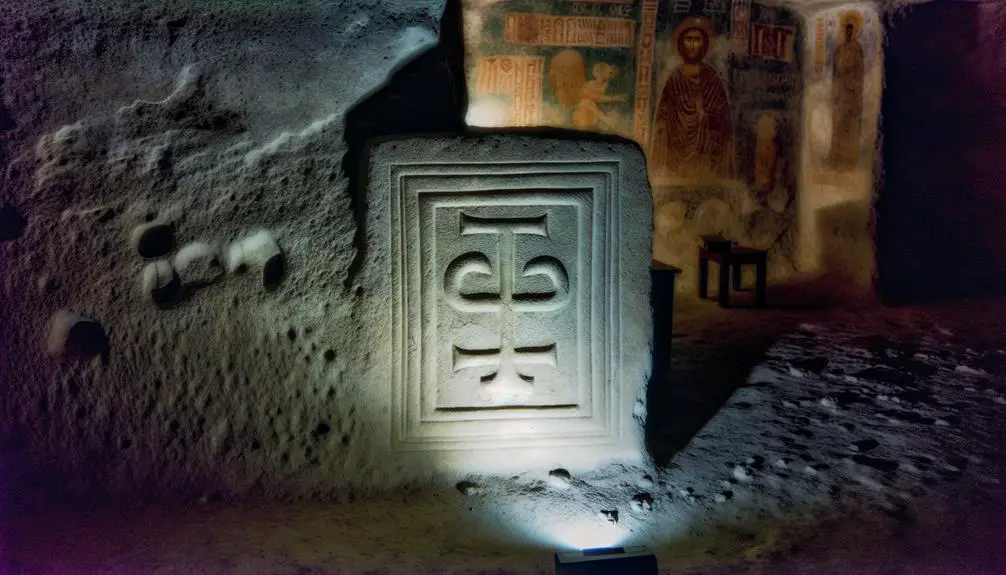What Does the Christian Symbol P with X Mean?
The Christian symbol resembling a 'P' with an 'X' is known as the Chi-Rho. This symbol originates from the superimposition of the Greek letters Chi (Χ) and Rho (Ρ).
Early Christians used it as a discreet marker of their faith, symbolizing Christ and his divine authority. The Chi-Rho gained prominence when Emperor Constantine adopted it following his vision before the Battle of the Milvian Bridge in 312 AD.
It was depicted in Christian art, illuminated in manuscripts, and inscribed in catacombs, symbolizing Christ's victory over death and his eternal reign. Continue to explore its rich history and enduring legacy.

Key Takeaways
- The Chi-Rho symbol combines the Greek letters Chi (X) and Rho (P) to represent Jesus Christ.
- Early Christians used the Chi-Rho as a secret sign of their faith during Roman persecution.
- Constantine adopted the Chi-Rho symbol after his vision, marking it on military standards for divine favor.
- The Chi-Rho appears in Christian art, mosaics, and illuminated manuscripts as a symbol of Christ's victory.
- In catacombs, the Chi-Rho symbolized eternal life, hope, and unity among early Christians.
Origins of the Chi-Rho

The Chi-Rho, an early Christian symbol formed by superimposing the first two letters of the Greek word 'Χριστός' (Christos), has its origins traced back to the early centuries of the Christian era.
This monogrammatic representation is believed to have emerged during the initial phase of Christianity's spread throughout the Roman Empire. The fusion of the Greek letters chi (Χ) and rho (Ρ) yielded a symbol that was not only visually distinctive but also theologically profound. It encapsulated the essence of Christ's identity amidst a mainly pagan society.
Archaeological evidence, such as inscriptions and artifacts, suggests its usage by early Christians to demarcate their faith discreetly. The Chi-Rho therefore stands as an emblematic indication of the nascent Christian community's resilience and devotion.
Significance in Early Christianity
The Chi-Rho, composed of the superimposed Greek letters Chi (Χ) and Rho (Ρ), carries a profound significance in early Christianity, symbolizing Christ and his divine authority. Emerging prominently in the 4th century, it not only marked ecclesiastical objects and vestments but also played a pivotal role in Constantine's vision and subsequent adoption of Christianity.
Understanding its origins and historical context provides valuable insights into its widespread acceptance and reverence among early Christians.
Origins and Meaning
Rooted in the early Christian era, the Chi-Rho symbol is represented by the superimposed Greek letters P (Rho) and X (Chi). It signifies the profound intersection of faith and identity for early believers. This emblem is derived from the first two letters of 'Christos' in Greek, encapsulating the divine presence and salvific mission of Jesus Christ.
Early Christians adopted the Chi-Rho as a covert signifier of their faith amidst persecution. They embedded it in catacombs, liturgical items, and manuscripts. Its use reflected a deep theological affirmation of Christ's dominion and the promise of salvation. The Chi-Rho served as a beacon of hope and a unifying emblem, becoming a potent symbol of Christian belief and communal resilience.
Historical Context Usage
Early Christian communities utilized the Chi-Rho symbol not only as a mark of identification but as a profound declaration of faith under the shadow of Roman persecution.
This emblem, formed by superimposing the Greek letters Chi (Χ) and Rho (Ρ), served as a clandestine yet powerful statement to Christ's divinity and the believers' unwavering commitment.
Its usage proliferated particularly after Emperor Constantine's vision and subsequent endorsement at the Battle of Milvian Bridge in 312 AD. The Chi-Rho thus became a revered icon, offering solace and solidarity to Christians facing martyrdom.
It encapsulated the hope of resurrection and eternal life, reinforcing communal bonds and spiritually fortifying those who bore it against the trials imposed by an oppressive regime.
The Greek Letters Explained

The Greek letters Chi (Χ) and Rho (Ρ), which combine to form the Christogram, trace their origins to the early Christian use of Greek as a liturgical language.
These letters were symbolically significant, representing Christ and serving as a concise profession of faith.
Today, the Chi-Rho continues to hold profound religious importance, intersecting ancient tradition with contemporary Christian symbolism.
Origin of Greek Letters
Emerging from the ancient Phoenician script, the Greek letters underwent a significant transformation in form and function, laying the foundation for the alphabetic systems used in the Western world today.
This profound evolution was not merely a linguistic shift but a cultural metamorphosis, encapsulating the intellectual and spiritual aspirations of ancient Greece. The Greeks adapted and modified the Phoenician characters to suit their own phonological needs, creating a more versatile and expressive script.
This adaptation included the introduction of vowels, a revolutionary change that enhanced clarity and precision in written communication. The Greek alphabet, with its rich symbolic resonance, became a cornerstone for subsequent alphabets, including Latin and Cyrillic.
Consequently, these letters carry an enduring legacy, deeply woven into the fabric of Western civilization.
Symbolic Religious Importance
Often revered for their profound spiritual significance, the Greek letters, particularly Chi (Χ) and Rho (Ρ), serve as potent symbols within Christian iconography. These letters form the Christogram, a monogram representing Jesus Christ. Chi, the first letter of "Christ" in Greek (Χριστός), and Rho, the second, intersect to create a symbol that has adorned altars, vestments, and manuscripts since early Christianity. This emblem signifies the presence and sovereignty of Christ, uniting believers through a shared visual language.
| Greek Letter | Name | Significance |
|---|---|---|
| Χ | Chi | First letter of "Christ" |
| Ρ | Rho | Second letter of "Christ" |
| ΧΡ | Chi-Rho | Christogram, symbol of Jesus |
This table encapsulates the essence of these letters' religious importance.
Modern Interpretations Today
In contemporary Christian practice, the Chi-Rho symbol continues to embody a profound theological and devotional essence, reflecting both historical reverence and modern spiritual interpretation. Derived from the Greek letters 'Χ' (Chi) and 'Ρ' (Rho), representing the initial letters of 'Christos' (Χριστός), this symbol signifies Christ's eternal presence.
Today, it is often seen in church iconography, liturgical vestments, and personal devotional items, serving as a visual affirmation of faith. Modern believers interpret the Chi-Rho as a reminder of Christ's sacrifice and resurrection, fostering a sense of unity and continuity with early Christian traditions. Its enduring presence underscores a timeless connection to the foundational truths of Christianity, bridging ancient faith with contemporary worship practices.
Use in Christian Art
The Chi-Rho symbol, characterized by superimposing the Greek letters P (Rho) and X (Chi), occupies a significant place in Christian art, often depicted in mosaics, frescoes, and illuminated manuscripts to represent the victory of Christ and the divine nature of His mission.
This emblematic representation is a visual proclamation of Christ's triumph over death and His eternal reign. In the intricate artistry of early Christian mosaics, the Chi-Rho often appears encircled by a wreath, symbolizing victory and eternal life.
Illuminated manuscripts, rich with theological significance, frequently feature the Chi-Rho, reflecting the deep reverence for Christ's divinity. As a devotional symbol, it serves not merely as an artistic element, but as a profound affirmation of faith and theological reflection.
Constantine's Vision and Adoption

Constantine's vision and subsequent adoption of the Chi-Rho symbol marked a defining moment in Christian history, intertwining faith and imperial power. According to historical accounts, before the Battle of the Milvian Bridge in 312 AD, Constantine experienced a heavenly vision in which he saw the Chi-Rho, accompanied by the words 'In this sign, conquer.' This divine encounter led him to adopt the emblem as a standard for his troops, fundamentally altering the trajectory of Christianity.
Emblematic significance: The Chi-Rho became a symbol of divine favor and protection.
Political implications: The adoption signified the merging of religious and state power.
Historical impact: The event facilitated the rise of Christianity within the Roman Empire.
Such a momentous adoption underscores the profound intersection of divine revelation and imperial authority.
Symbolism in Manuscripts
Within the illuminated manuscripts of early Christianity, the Chi-Rho symbol emerged as a profound representation of Christ's authority and divine presence.
This sacred monogram, combining the Greek letters Chi (Χ) and Rho (Ρ), often adorned the opening pages of Gospels and liturgical texts, signifying the sanctity and divine inspiration of the words contained within.
The meticulous artistry and devotion invested in these manuscripts reflected the reverence held for Christ and his teachings. By embedding the Chi-Rho within elaborate decorative elements, scribes not only honored Christ but also conveyed a theological message of spiritual sovereignty and salvation.
The symbol served as a visual attestation to the manuscript's sacred purpose, guiding the faithful in their devotional and scholarly pursuits.
Chi-Rho in Catacombs

Amid the labyrinthine catacombs of early Christian communities, the Chi-Rho symbol stands as a poignant confirmation to the believers' faith and hope in resurrection. This emblem, combining the Greek letters Chi (Χ) and Rho (Ρ), served as a clandestine yet profound declaration of Christ's sovereignty.
The catacombs, with their dimly lit passageways, became sanctuaries adorned with this sacred monogram, signifying:
- Eternal Life: Embodying the promise of resurrection through Christ.
- Christian Identity: A covert signifier of the faithful during times of persecution.
- Communal Hope: Offering solace and unity among early Christians.
The Chi-Rho within these burial grounds underscores the integration of spiritual conviction and communal identity, transcending the perilous era in which it thrived.
Evolution Through the Centuries
The Chi-Rho symbol, deeply rooted in early Christian iconography, has undergone significant transformations in its representation and interpretation throughout the centuries. Initially used by Constantine the Great, it became a powerful emblem of divine favor. Over time, its design and contextual usage evolved, reflecting the theological and artistic shifts within the Christian tradition.
| Century | Representation | Interpretation |
|---|---|---|
| 1st-3rd | Engraved on catacombs | Symbol of Christ's presence and hope |
| 4th-6th | Imperial insignia | Sign of divine authority and victory |
| Medieval | Manuscripts, churches | Emblem of sacred art and theology |
| Modern | Diverse adaptations | Continues to inspire faith and unity |
The symbol's enduring presence underscores its profound spiritual significance and adaptability.
Modern Interpretations and Uses

In contemporary contexts, the Chi-Rho symbol continues to be a potent emblem, manifesting in various liturgical settings, artistic expressions, and personal devotionals. This ancient Christogram, rich in theological significance, is employed to evoke the presence and authority of Christ in modern Christian practice.
- Liturgical Settings: The Chi-Rho adorns vestments, altars, and sacred vessels, reinforcing the sacredness of worship.
- Artistic Expressions: It appears in religious art, from stained glass windows to modern digital designs, symbolizing the eternal nature of Christ's reign.
- Personal Devotionals: Many Christians wear Chi-Rho jewelry or incorporate it into personal prayer spaces, fostering a tangible connection to their faith.
Thus, the Chi-Rho remains a profound demonstration to Christ's enduring legacy.
Conclusion
The Chi-Rho symbol, emerging from early Christian contexts and imbued with rich theological significance, has traversed centuries as a profound emblem of faith.
From Constantine's transformative vision to its incorporation in manuscripts and catacombs, the symbol's enduring legacy persists in modern Christian art and iconography.
For example, a contemporary church might incorporate the Chi-Rho in its stained glass windows, thereby connecting present-day worshippers with the ancient traditions and spiritual heritage of early Christianity.






